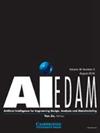A method to explore strategies to communicate user experience through storyboards: an automotive design case study
IF 2.3
3区 工程技术
Q3 COMPUTER SCIENCE, ARTIFICIAL INTELLIGENCE
Ai Edam-Artificial Intelligence for Engineering Design Analysis and Manufacturing
Pub Date : 2022-03-21
DOI:10.1017/S0890060421000287
引用次数: 2
Abstract
Abstract An engaging user experience is an increasingly important design characteristic in the automotive industry. Compared with physical design characteristics (form, material, mechanical design, appearance), automotive designers find UX (user experience) challenging to communicate during the early stages of the design process without investing in expensive prototypes and/or models. This paper presents the development of a method to explore strategies to communicate UX through the medium of storyboards early in the design process. The method enables links to be drawn between the design tool of storyboarding and the attributes of theoretical UX outlined in theoretical frameworks. By applying this method in a case study of a storyboard created by Ford Design Asia Pacific, we identify how the theoretical attributes of UX are manifested, and we also highlight certain attributes of UX that are difficult to convey during the early phases of automotive design. This research thus contributes a method relevant to practice that assists with effectively communicating UX in early-stage automotive design where higher fidelity prototyping is unviable. Additionally, it enables the study of storyboard outcomes in the design process to assess the degree to which the intended UX is communicated. In doing so, it contributes a first step toward formalizing the analysis of UX in concept design, which in turn opens up this highly subjective area to further research in the automated analysis of conceptual design and even generative design.探索通过故事板传达用户体验的策略:一个汽车设计案例研究
引人入胜的用户体验是汽车行业日益重要的设计特征。与物理设计特征(形式、材料、机械设计、外观)相比,汽车设计师发现,如果不投资于昂贵的原型和/或模型,在设计过程的早期阶段沟通UX(用户体验)是一项挑战。本文介绍了一种方法的发展,探索在设计过程的早期通过故事板媒介进行用户体验沟通的策略。该方法可以在故事板的设计工具和理论框架中概述的理论用户体验属性之间建立联系。通过将这种方法应用于福特设计亚太公司创建的故事板案例研究中,我们确定了用户体验的理论属性是如何体现的,并且我们还强调了在汽车设计的早期阶段难以传达的用户体验的某些属性。因此,这项研究提供了一种与实践相关的方法,有助于在早期汽车设计中有效地沟通用户体验,在这种情况下,高保真度的原型是不可实现的。此外,它可以研究设计过程中的故事板结果,以评估预期用户体验的沟通程度。在这样做的过程中,它为形式化概念设计中的用户体验分析迈出了第一步,这反过来又为概念设计甚至生成设计的自动化分析开辟了这个高度主观的领域。
本文章由计算机程序翻译,如有差异,请以英文原文为准。
求助全文
约1分钟内获得全文
求助全文
来源期刊
CiteScore
4.40
自引率
14.30%
发文量
27
审稿时长
>12 weeks
期刊介绍:
The journal publishes original articles about significant AI theory and applications based on the most up-to-date research in all branches and phases of engineering. Suitable topics include: analysis and evaluation; selection; configuration and design; manufacturing and assembly; and concurrent engineering. Specifically, the journal is interested in the use of AI in planning, design, analysis, simulation, qualitative reasoning, spatial reasoning and graphics, manufacturing, assembly, process planning, scheduling, numerical analysis, optimization, distributed systems, multi-agent applications, cooperation, cognitive modeling, learning and creativity. AI EDAM is also interested in original, major applications of state-of-the-art knowledge-based techniques to important engineering problems.

 求助内容:
求助内容: 应助结果提醒方式:
应助结果提醒方式:


